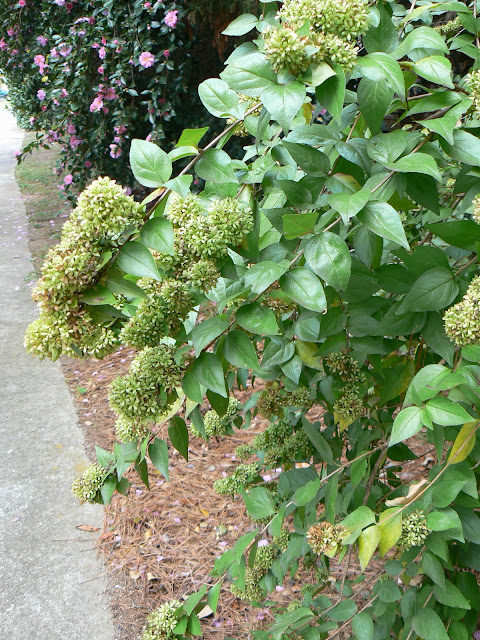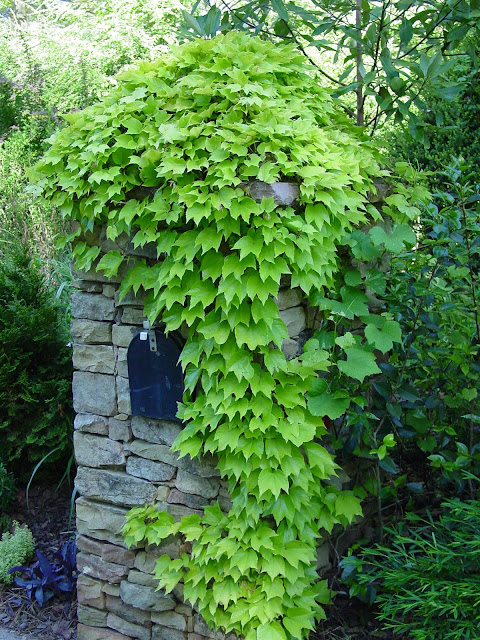I like to stick to photographs of plants and gardens, but I kept coming across this picture I'd put on my blog list. I'm not sure exactly why I included it among landscape features and close-ups of flowers and such. It was a haphazard, unplanned arrangement - it must have caught my eye one day - and I snapped a picture. Upon examination, it brings back a lot of unconnected memories.
First, see those tiles on the backsplash? I bought them in a little town in France sometime in the early 80's. They came with either green or blue hearts in the corners. I'm a regretter, and the moment I had them packed up so I could carry them on the plane (remember those days? I also brought an iron rooster weather vane home on the same flight), I wished I had bought the ones with the green. Sorry to say, I haven't ever let that go. I did go back to the little town (name escapes me now) in 2002 to see if they still had the green ones. They didn't. Nor did they have anything similar in any color.
The trip to Provence in 2002 yielded the peeling still life painting that is propped up in back of this little kitchen scene. I was staying with friends, but I rented my own car and drove over to a tiny village where I found a very scrubby market, just as it was closing. I bought some mustard colored pottery pieces and this painting. It's not very good, but it goes with my kitchen.
The market basket belonged to my mother and daddy. They were great vegetable gardeners, so that basket was filled many, many times over the years. And, the canned soup mix and tomatoes were put up by my mother. The date on the piece of masking tape on the tomatoes: 2001. My mother was born in 1910, so that meant she was 91 when she did that canning. It also meant that Daddy and Mother had grown the Silver Queen corn, the baby limas, the okra and the tomatoes.
The bronze fig was made by Frank Fleming, a well-known sculptor from Alabama. His large animal figures sit in a fountain at Five Points South in Birmingham. Frank was a subject for an episode of A Gardener's Diary. He took objects from nature and used the forms for sculptures and pieces of furniture. His most famous works, though, are of whimsical animals.
The yellow bowl I picked up at Scott's Antique Market in Atlanta, and the vase, I'm embarrassed to say, is one of the few survivors of my attempts to become a potter. That effort back in the early 1970's mercifully didn't last long, as I never could get anything balanced on the wheel. If only I'd spent the pottery lesson money on some nice pieces from a talented artist. The bouquet consists of Sedum 'Autumn Joy', and a bunch of weeds and grasses from my late parents' farm.
Last but not least are those buckeyes in the yellow bowl. My daddy believed that buckeyes brought good luck. Every September he would go down to this little lane on the farm where a 20 foot tall buckeye tree grew. He would collect the shiny dark seeds that came out of a shell that sort of looked like a cross between a kiwi and a walnut. He kept them in his pockets, and every time he would meet anyone new, he'd give them a buckeye. He'd done it for years, and almost everyone in our small town had one of his buckeyes.
His health began to fail in 2002, and he died in September 2004. The Saturday before he died, I took him down to see if we could find any buckeyes. I gasped in horror to see that his buckeye tree had fallen over and was dead. He was so disappointed, and I was just sick. We started riding further down the lane, and I happened to look over and see a spindly little tree with what looked like khaki colored eggs hanging from the branches. Buckeyes!
I pulled over and rolled down Daddy's window, and he reached up and pulled off the capsules, which were beginning to open. We took them back to the house, and he had a great time pulling out the shiny brown seeds, some almost as large as a ping-pong ball.
At his funeral the next week, we passed out buckeyes. My niece and I had gone back down there to find dozens more small trees laden with fruit. I wrote a tear jerker eulogy about how the big tree was a metaphor for life. It had fallen over and had its day, but a lot of fresh new trees had come along to take its place.
To end on a cheerier note, I'm glad to say the buckeye trees are still producing, and I have a great time riding around the farm and picking weeds for arrangements at Thanksgiving and cedar and sweet gum branches for Christmas. All that stuff is still there on my kitchen counter, in addition to the six jars of okra pickles I put up this year. I'd like to try my hand at some soup mix. We grew okra, tomatoes and Silver Queen corn this year. Next year, we'll have to grow some lima beans. Then, all you have to do on a winter day is cut up some onions and potatoes, boil a soup bone, and you have yet another good memory.











